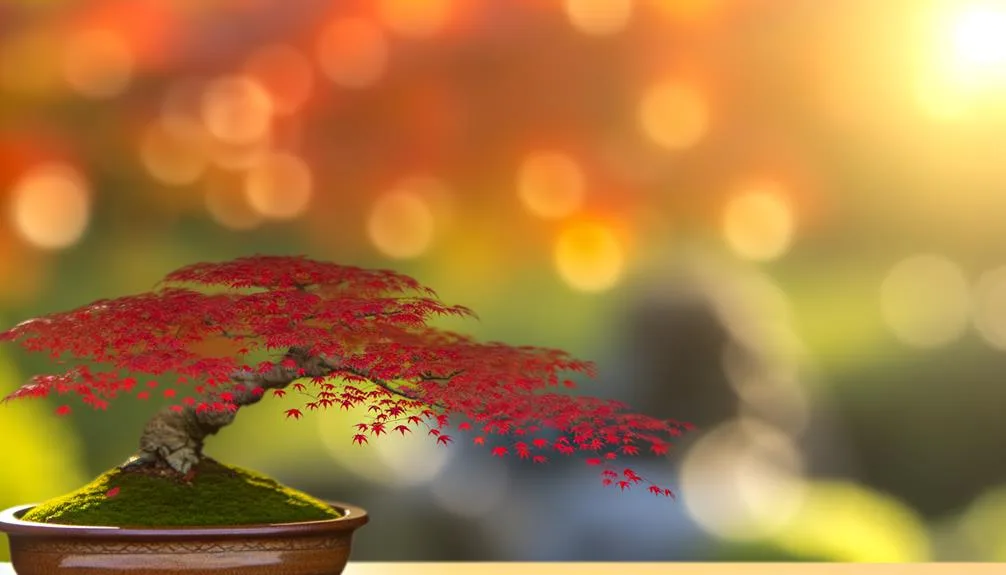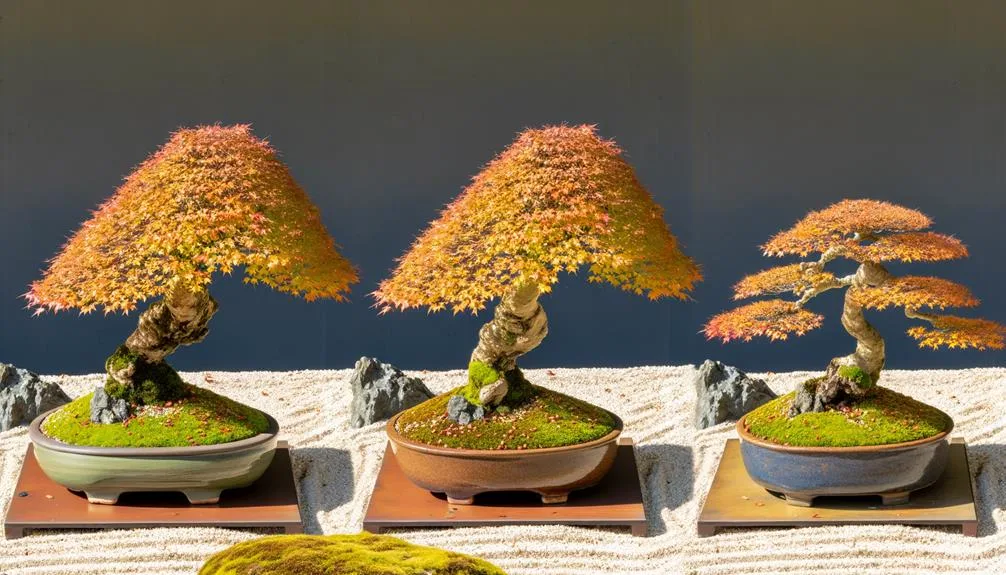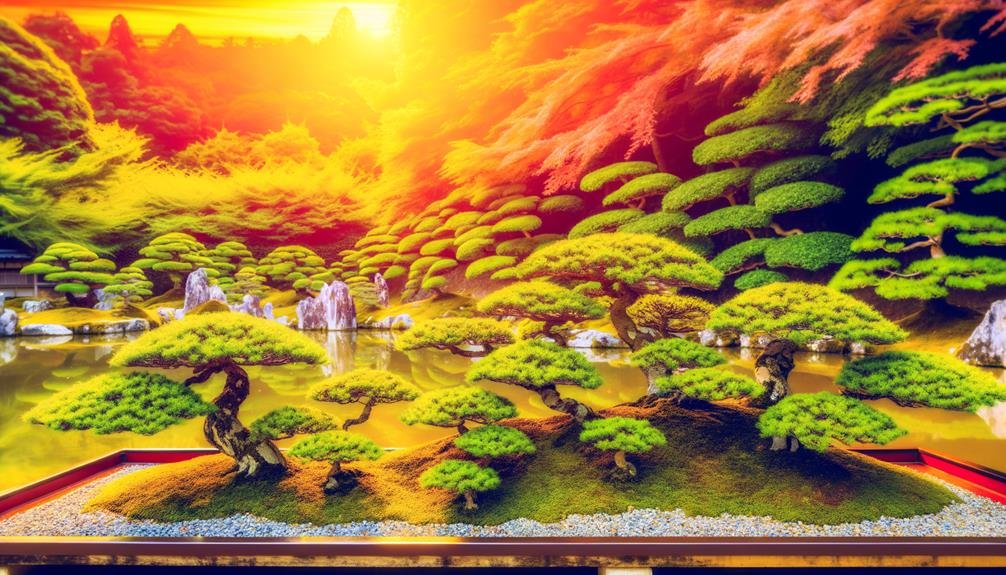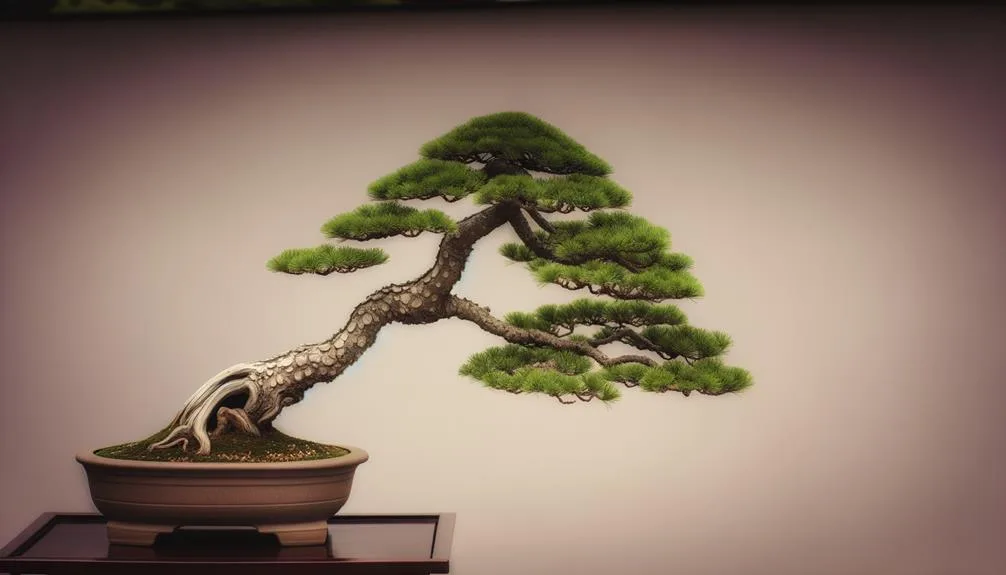A Semi-Cascade Bonsai Tree is a captivating and aesthetically unique style of bonsai that mimics the appearance of a tree growing on a slope or cliffside, where its trunk and branches gracefully cascade downward. In this style, the tree’s main trunk emerges vertically from the soil but then bends and cascades downward, creating a sense of movement and drama.
Just as I’ve marveled at the way a tree can cling to the side of a cliff, defiant and beautiful, I’ve found that the semi-cascade bonsai trees capture this very essence in miniature form. These tiny giants, with their branches cascading downwards and outwards, echo the resilience and grace of their larger counterparts in the wild that I’ve observed.
They’re a testament to the art of bonsai, a practice that I’ve learned is as much about patience as it is about skill. But how exactly do these trees maintain their elegant fall? And what makes them different from other bonsai styles that I’ve encountered?
Well, I think it’s time we explore these intriguing questions together.
Key Takeaways
- Semi-cascade bonsai trees mirror plants on cliff edges or exposed slopes.
- The cascade style is characterized by a twist upward at the lowest branch’s tip.
- The container for these trees is generally flat with a reduced surface area but deeper.
- Semi-cascade bonsai trees require a sturdy root system for balance.
Semi-Cascade Bonsai Trees
The design of semi-cascade bonsai trees mirrors plants located on cliff edges or exposed slopes. They possess a distinct shape as their branches expand outward and downward due to less pressure. This downward expansion, along with a twist upward at the lowest branch’s tip, results in the elegant fall of semi-cascade bonsai trees. This cascade style is truly distinctive.
The container for these trees is generally flat with a reduced surface area, but is also deeper to accommodate this special growth pattern. If you’re thinking about giving this a try, potentilla fruiticosa, cotoneaster, natal plum, firethorn, fuchsia, and juniper are appropriate plants. The winter care regimen for these trees varies, so it’s crucial to do your homework.
Grasping the nature of semi-cascade bonsai trees involves more than just comprehending their shape and structure, or the correct pot to use. It’s also about valuing the aesthetics and innate look they provide. The lower branches expand downward and outward, while the leaves reach upward, as if striving for light. This is what renders semi-cascade bonsai trees a fulfilling and pleasurable pastime – it’s a personal artistic expression of nature.
History and Origin of Semi-Cascade Style
You might wonder where the semi-cascade bonsai style comes from. Its roots are deep in the ancient art of bonsai, handed down for many generations.
Let’s look at how this style has evolved over the years.
Ancient Roots of Semi-Cascade
Investigating the olden origins of the semi-cascade style, it’s captivating to see that it’s been employed for centuries to reflect the natural growth of plants on harsh terrains like cliffs and stony beaches. This style of bonsai mirrors the endurance of nature, with its branch growth both descending and extending, yet always reaching upwards towards the light.
Characteristic features of the semi-cascade bonsai trees consist of:
- Descending and extending branch growth
- Sturdy root system for balance
- Appropriate for a variety of plant species
- Attractive and distinct planter pots
Recognizing the olden origins of semi-cascade helps to value the artistry and technique involved in this bonsai style. As you become proficient in this style, you’ll be amazed at how it encapsulates the beauty and hardiness of nature in a miniature form.
Evolution of Semi-Cascade Style
Let’s journey back in time to examine the origins of the semi-cascade style of bonsai, a variant of the cascade style, deeply entrenched in traditional Japanese bonsai customs.
The progression of the semi-cascade style pays homage to humanity’s aspiration to replicate the tenacity and elegance of nature. These semi-cascade bonsai trees mimic the growth habits of trees situated on cliffs or coasts, where branches extend downward while the foliage strives upwards for sunlight.
Species like juniper or fuchsia are ideal for this bonsai style, each adding distinct features to the overall design. As a bonsai master, knowing the specific needs of your selected species, particularly during winter, helps your cascade bonsai maintain its grace.
The Art of Shaping Semi-Cascade Bonsai

The technique of shaping semi-cascade bonsai trees relies heavily on meticulous training, accurate pruning, and careful selection of both plant species and pot. The elegant downward posture of your bonsai trees is the result of methodical planning and execution.
The semi-cascade bonsai style demands a sharp eye and a firm hand. From the first stages of shaping to the preservation of the form, each step is vital. The tree’s trunk should curve downwards, but not reach below the base of the pot.
Keep these elements in mind when shaping your semi-cascade bonsai:
- Opt for an appropriate plant species. Prunus and Juniper are excellent choices.
- Pick a pot that matches your tree’s size, form, and style.
- Instruct the tree to hold the semi-cascade structure.
- Prune on a regular basis to maintain the preferred shape.
Cultivation and Care Tips
To successfully grow a thriving semi-cascade bonsai, initiate training your tree in the cascade style at the earliest, providing it ample time for shaping and growth. This is a crucial cultivation and care tip, which allows your tree to display its natural grace in a controlled environment.
Regularly inspect the bindings that shape your tree. Ensure they’re secure, but not causing harm to your bonsai. This delicate balance is crucial for healthy growth.
The choice of planter pot is also important. It should complement your bonsai and contribute to its form. Maintain the pot in good condition, warding off any damage that could affect the tree’s health.
Study the natural growth patterns of trees. This knowledge aids in designing a realistic and harmonious semi-cascade bonsai. The key is to learn to observe and follow nature’s lead.
In terms of selecting a plant for your semi-cascade bonsai, options include potentilla, cotoneaster, natal plum, firethorn, fuchsia, or juniper. Each plant offers its own unique beauty, but it’s important to remember to provide appropriate winter care. Maintain the tree’s health by taking into account its needs and the climate.
Common Semi-Cascade Bonsai Species

You might be wondering what types of bonsai trees are best for the semi-cascade style.
Well, some of the most popular include junipers, pines, certain maples, flowering cherry trees, and Potentilla fruticosa.
Each of these species lends itself well to the semi-cascade style and offers its own unique aesthetic appeal.
Popular Semi-Cascade Species
Semi-cascade bonsai trees are commonly represented by species such as juniper, pine, and maple, all chosen for their distinct traits. These trees are an excellent choice for crafting a 36-inch semi-cascade bonsai, a favored selection among hobbyists.
Outlined below are some prevalent semi-cascade species:
- Juniper: This tree’s resilience and year-round beauty make it a popular choice.
- Pine: The sturdy nature of this tree earns it high favor.
- Maple: This tree, recognized for its vibrant fall colors, introduces a pop of color.
- Prunus: This flowering cherry is a stunning option due to its delicate and vibrant flowers.
The care of these cascading bonsai species necessitates advanced skills, making them unsuitable for novices. However, with patience and practice, mastering these stunning trees is achievable.
Caring for Semi-Cascades
Having gone over the prevalent semi-cascade species, we shall now consider the methods of caring for these beautiful bonsai trees.
Initially, select plants such as juniper, pine, or maple, which are well-suited to the semi-cascade style. Ceramic pots should be used to maintain equilibrium and imitate the elegant fall of semi-cascade bonsai trees.
Consider winter care, as some species mightn’t survive outside in pots due to fluctuations in temperature. Make sure to prune, shape, water, and provide nutrients to your bonsai regularly, while also checking for pests and diseases to ensure its wellbeing.
Incorporate natural materials like moss and rocks to help your bonsai mimic its natural growth pattern.
The care of semi-cascades isn’t solely about maintenance, but also about preserving the distinct styles of bonsai.
Semi-Cascade Aesthetic Appeal
Exploring the realm of semi-cascade bonsai reveals their distinct aesthetic allure, with each species, from Prunus to pine, offering its own special traits. Their appealing descent, beginning from the trunk’s base, emulates patterns observed in nature.
The aesthetic allure of the semi-cascade style can be encapsulated in the:
- Graceful fall of the branches, mirroring natural growth patterns
- Choice of species, each contributing to the overall design
- Use of ceramic pots, augmenting visual appeal and stability
- Inspiration from nature for a lifelike appearance
Through practice, the skill of sculpting these trees becomes both demanding and fulfilling. Over time, your appreciation of their beauty will grow, refining your proficiency in this craft.
Inspirational Semi-Cascade Bonsai Displays

You’ll uncover that semi-cascade bonsai displays beautifully reproduce nature, imitating the elegant motion of trees growing on cliff faces, rocky coastlines, or windswept hilltops. This style represents trees that exhibit a strong determination to survive, their primary trunk twisting and turning as if molded by the elements.
Inspirational semi-cascade bonsai displays can be genuinely awe-inspiring. This style of bonsai is distinctive in its design, requiring a high degree of expertise and patience. The main trunk of the tree grows outward and then downward, often extending below the base of the pot, giving the impression of a tree growing over the edge of a cliff.
Ceramic pots are frequently selected for their durability, complementing the tree’s aesthetic and providing stability for its downward growth. The result is the elegant fall of semi-cascade bonsai trees, a sight certain to inspire any bonsai enthusiast.
Whether it’s a Prunus or a Juniper, each semi-cascade bonsai provides a unique visual spectacle. The cascading branches create a refined display, showcasing the beauty of nature in miniature form. These displays often appear in bonsai exhibitions, admired for their harmony and realism.
Frequently Asked Questions
What Is the Most Sought After Bonsai Tree?
You’re likely seeking semi-cascade bonsai trees. They’re admired for unique aesthetics and require specific bonsai care, potting techniques, and soil composition. Mastery in handling different bonsai species ensures their healthy, graceful fall.
What Is the Difference Between Semi Cascade and Cascade Bonsai?
Semi-cascade bonsai’s aesthetics involve a graceful, less dramatic fall than cascade’s, symbolizing resilience. Pruning distinctions help maintain this form, and suitable species like Prunus and juniper are often used. You’ll master it with practice!
What Is the Rarest Bonsai Tree in the World?
You’re curious about the world’s rarest bonsai? It’s the Bonzai Redwood, a semi-cascade beauty. Its cultivation challenges, ancient specimen status, and unique symbolism make it a pinnacle of bonsai art. Truly, it’s a bonsai master’s dream.




